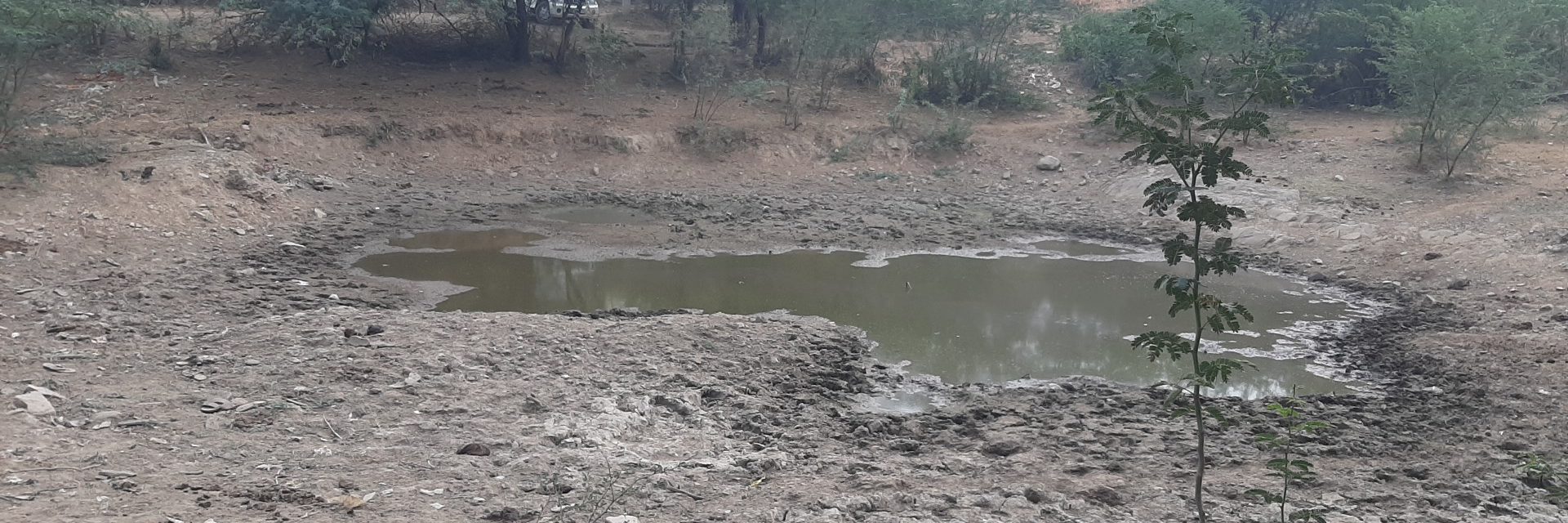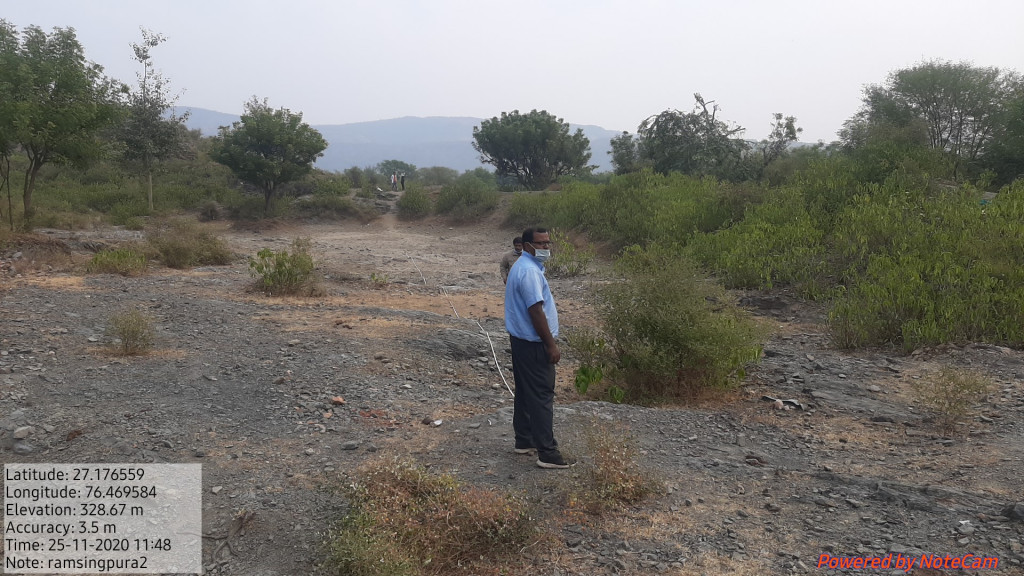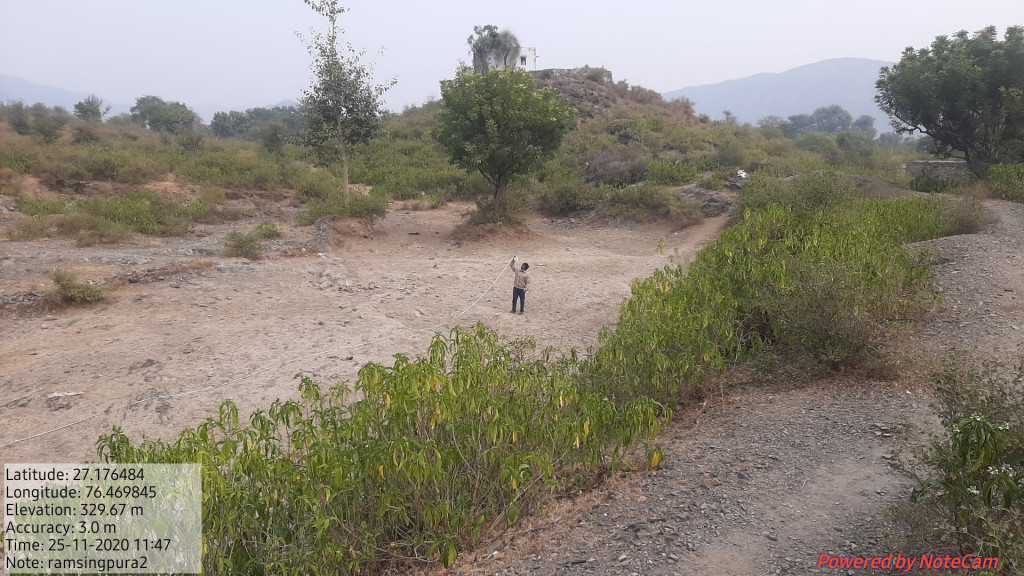Alwar, Rajasthan, India
In collaboration with

October 2020 – June 2021
We study with the community the hydrological course of the basin to obtain the maximum amount of water during the monsoon rains and regenerate the groundwater masses. We mobilize communities to understand the importance of planting trees and improving green cover to tackle climate change.
Objectives
- To provide communities with adequate watershed management capacity to mitigate droughts.
- To improve water conservation through management of natural and manmade water bodies.
- To recover green coverage in the area, especially in dried wastelands.
Beneficiaries
3,000 direct
Mostly landless agricultural workers and landowner farmers. They are responsible for managing water resources in the village.

On the ground
Farmers are impoverished by droughts and the poor state of traditional monsoon rainwater harvesting systems. There is a high rate of migration to cities and malnutrition among children.
A 2016 report by the Indian parliamentary committee on restructuring the Central Water Commission and the Central Ground Water Board, says “the growing dependence on groundwater has taken the form of unsustainable over-extraction, which is lowering the water table and adversely impacting drinking water security.” According to the World Economic Forum, India extracts more groundwater than any other country in the world.
Widespread depletion of water causes situations of drought across the country.
The generalized depletion of water causes drought situations throughout the country. Droughts have multiple effects on communities, especially on children, by reducing food security, increasing poverty and malnutrition, and aggravating community conflicts, among others.
Alwar, in Rajasthan, is characterized by the over-exploitation of groundwater through tube wells for irrigation and the use of groundwater by industries. On the other hand, the electricity subsidized to farmers increases to the overextraction of water.
The majority of the population are poor and marginalized farmers who depend primarily on agriculture and livestock for livelihoods. Traditional rainwater harvesting systems such as johads, paals, and bandhs are in a neglected state, so the water from monsoon rains is not collected and is lost through runoff. And there are no perennial rivers that can meet the needs of the people.
Lack of water during harsh summers affects the livelihoods of farmworkers and marginalized farmers, leading to huge debts due to loss of income. Migration to cities and malnutrition among children are other of the worst effects. The felling of trees for rapid urbanization and industrialization also causes detrimental climatic effects such as low rainfall and prolonged droughts in the region due to the loss of natural green cover.
COVID-19 has caused widespread uncertainty throughout the population. A drought scenario with lack of water would increase the anguish among the population. Communities need adequate access to water for livelihood and for domestic use, especially during harsh summers.
With widespread unemployment in the communities, the project will seek to provide short-term employment in its own tasks, such as strengthening embankmentsto prevent from floods, pruning shrubs and reforesting. Thus, helping day laborers will contribute to improving the financial security of the community.

In detail
This project will aim to engage with the communities in the selected villages to improve the proper management of the community’s water resources with improved watershed structures and adaptable resource management techniques.
The project will be implemented with the participation of the community at each stage. Traditional community water conservation practices will be considered when planning solutions for watershed development. The Community will also participate in the selection of water bodies suitable for development in order to improve the impact for the beneficiaries.
In accordance with government protocol, low-income community members enrolled in the The Mahatma Gandhi National Rural Employment Guarantee Act (MGNREGA)will be employed in certain project activities such as embankment strengthening, shrub pruning, and reforestation. Thus, helping day laborers will contribute to improving the financial security of the community.
Planned implementation methods and their advantages are:
- Combination of community based labour and use of machinery for for speedy implementation of the project.
- The course of the watershed is looked into to get the maximum amount of water during monsoon rains. Water collected during the rains will help for surfacewater storage and lead to percolation of water to improve ground water levels.
- The project includes the important aspect of soil conservation and improving the green cover to mitigate the impact of climate change. Communities will be mobilized to understand and act on the importance of planting trees and improving green cover. Triggering slow growing tree stumps for faster growth has been a successful strategy in enhancing the green cover.
Perspectives of sustainability
As communities mobilize through the water user committees, they are empowered to manage the watershed in the future. This project will work closely with community organizations, farmer groups, the Department of Agriculture – Krishi Vigyan Kendra (KVK), the Panchayat village, the District and State Governments.
Women are important stakeholders and are negatively affected during droughts, as the burden of collecting water for the home falls on them. Addressing women’s issues by involving them in water user groups and promoting leadership and decision-making roles among them will facilitate their long-term ownership of the project and its sustainability.


